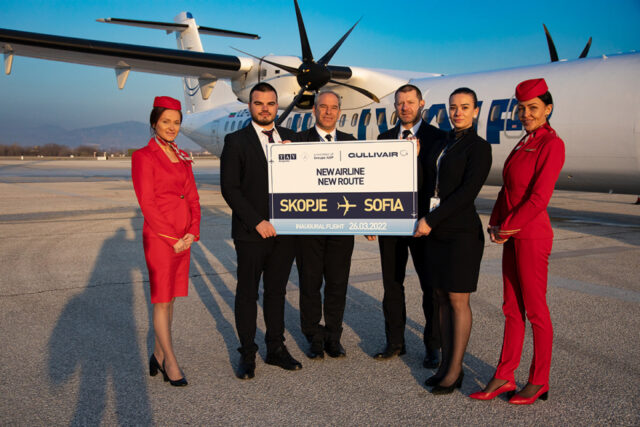TAV Macedonia’s rainbow-shaped water bridge Saturday morning welcomed Gullivair’s ATR 72-600 aircraft, a 70-seat economy class plane, which landed at Skopje International Airport at 5:48 am and marked the start of the first regular commercial Sofia – Skopje flight in 15 years.
Minister of Transport and Communications Blagoj Bocvarski welcomed the first passengers off the plane, saying Macedonia had a lot to offer to Bulgarian tourists.
“I’m happy that in a very short time we reached an agreement and launched this flight together with the Republic of Bulgaria,” Bocvarski said.
“Things are moving in the right direction,” he said. “We remain committed with our friends in the coming period in finding solutions that will strengthen friendly relations and that will bring economic benefits to both countries.”
The Ministry of Transport and Communications, he added, would continue to work on policies to develop national air traffic and ease travel.
“We are happy the airline started flying to and from Skopje airport despite the current crisis with the covid pandemic,” TAV Macedonia general manager Metin Batak said.

Batak highlighted the potential of the flight to contribute “not only to the development of Macedonian aviation but also to business cooperation between the two countries.”
Thanking the two countries’ transport ministers for making the Sofia –Skopje flight possible, the Bulgarian air carrier Gullivair’s CEO Georgi Kolev said the direct connection would boost bilateral relations and facilitate travel to other destinations, as well.
In addition to Gullivair’s new Burgas, Skopje, and Tirana flights, Kolev said, the air carrier would be launching new flights to New York and New Delhi this summer.
Tickets for the regular flights every Saturday and Monday are available through Gullivair online. The duration of the Sofia –Skopje flight is 30 minutes.
According to TAV Macedonia, a total of 215,227 passengers passed through the Skopje and Ohrid airports in January and February, an increase of 107 percent from 2021 but a decline of 29 percent from 2019.





Comments are closed for this post.